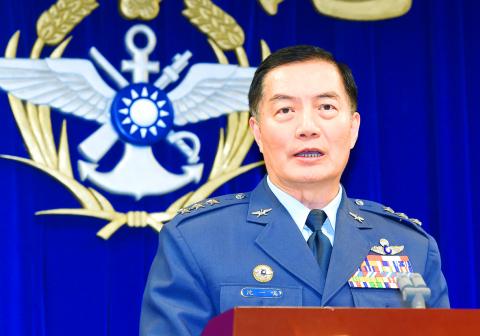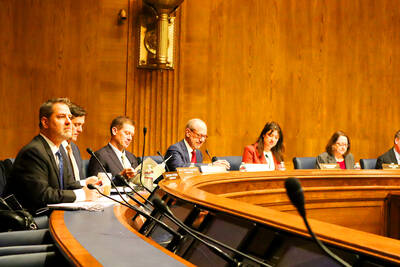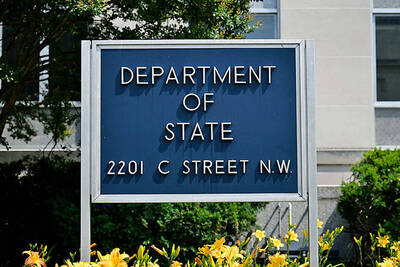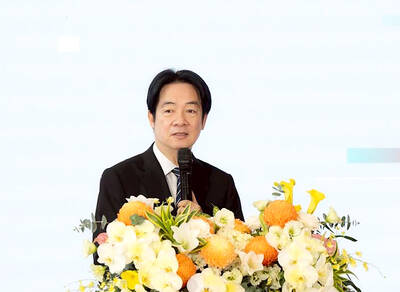The military has officially requested new fighter jets from the US, the Ministry of National Defense said yesterday, adding that Washington was asked to advise on the type and number of fighter jets that would be required to meet Taiwan’s operational needs.
The Air Force Command has been planning to procure new fighter jets since 2003, as the aircraft in its service are nearing the middle of their service life, Deputy Minister of National Defense Shen Yi-ming (沈一鳴) told a news conference in Taipei.
The minister’s remarks clarified the ministry’s partial confirmation on Wednesday of a report in the Chinese-language Apple Daily that said it was considering a US$13 billion deal for 66 F-16Vs, including training and servicing.

Photo: Liao Chen-huei, Taipei Times
Shen and other defense officials yesterday said a request has been sent to the US, but that media outlets were incorrect about the details.
Shen rejected a report by the Chinese-language China Times saying that the deal had originated with the US government, and that it was overpriced and designed to facilitate a visit to the US by President Tsai Ing-wen (蔡英文) ahead of the presidential election next year.
“The story is sheer speculation and utterly without any basis in fact,” Shen said. “The ministry strongly protests the report and we demand that the news agency responsible retract the story.”
The air force considers Lockheed Martin F-16A/B/Vs, Dassault Mirage F-2000-5s and AIDC F-CK-1s its best fighters, of which there are 326, but the Chinese People’s Liberation Army’s growing air power is causing an “imbalance” across the Taiwan Strait, Air Force Chief of Planning Major General Tang Hung-an (唐洪安) said.
The military would not object to any type of jet fighter that meets its operational requirements and would make no mention of “what the armed forces want” in any communications with the US, Tang said.
Instead, the military would wait for the US’ recommendations, and then select and negotiate the price accordingly, Tang said.
A program to upgrade F-16A/Bs to F-16Vs is behind schedule, but the air force is conducting monthly meetings with Aerospace Industrial Development Corp (AIDC, 漢翔航空工業), Lockheed Martin and the American Institute in Taiwan (AIT), Tang said.
Meanwhile, the air force expects AIDC to increase its staff and technical capabilities to the point that it could begin retrofitting 24 F-16Vs per year, Tang said.
Ministry spokesman Major General Chen Chung-chi (陳中吉) said the plan for the new fighter jets is about enhancing air defense capabilities, not replacing existing jets.
The F-16V carries the AN/APG-83 radar, which means it has an improved detection range and fire-control compared with its predecessors. It can also be equipped with AIM-9X missiles linked to a helmet-mounted cueing system.
AIT spokeswoman Amanda Mansour said that it is the policy of the US government not to comment on proposed defense sales or transfers until the US Congress has been formally notified.
“Without speaking to any specific cases, we can say that under long-standing US policy, US arms sales to Taiwan are guided by the Taiwan Relations Act [TRA] and based on an assessment of Taiwan’s defense needs,” Mansour said.
The US and Taiwan have a strong defense relationship and have maintained continuous communication regarding the latter’s defense requirements, she said.
Across decades and presidential administrations, the US has remained deeply committed to meeting Taiwan’s defense needs, she said.
“This administration is resolved to fully implement the provisions of the TRA under which the US makes available to Taiwan defense articles and services necessary to enable Taiwan to maintain a sufficient self-defense capability,” she added.
Additional reporting by Stacy Hsu

MISINFORMATION: The generated content tends to adopt China’s official stance, such as ‘Taiwan is currently governed by the Chinese central government,’ the NSB said Five China-developed artificial intelligence (AI) language models exhibit cybersecurity risks and content biases, an inspection conducted by the National Security Bureau (NSB) showed. The five AI tools are: DeepSeek, Doubao (豆包), Yiyan (文心一言), Tongyi (通義千問) and Yuanbao (騰訊元寶), the bureau said, advising people to remain vigilant to protect personal data privacy and corporate business secrets. The NSB said it, in accordance with the National Intelligence Services Act (國家情報工作法), has reviewed international cybersecurity reports and intelligence, and coordinated with the Ministry of Justice Investigation Bureau and the National Police Agency’s Criminal Investigation Bureau to conduct an inspection of China-made AI language

LIMITS: While China increases military pressure on Taiwan and expands its use of cognitive warfare, it is unwilling to target tech supply chains, the report said US and Taiwan military officials have warned that the Chinese People’s Liberation Army (PLA) could implement a blockade within “a matter of hours” and need only “minimal conversion time” prior to an attack on Taiwan, a report released on Tuesday by the US Senate’s China Economic and Security Review Commission said. “While there is no indication that China is planning an imminent attack, the United States and its allies and partners can no longer assume that a Taiwan contingency is a distant possibility for which they would have ample time to prepare,” it said. The commission made the comments in its annual

CHECKING BOUNDARIES: China wants to disrupt solidarity among democracies and test their red lines, but it is instead pushing nations to become more united, an expert said The US Department of State on Friday expressed deep concern over a Chinese public security agency’s investigation into Legislator Puma Shen (沈伯洋) for “secession.” “China’s actions threaten free speech and erode norms that have underpinned the cross-strait ‘status quo’ for decades,” a US Department of State spokesperson said. The Chongqing Municipal Public Security Bureau late last month listed Shen as “wanted” and launched an investigation into alleged “secession-related” criminal activities, including his founding of the Kuma Academy, a civil defense organization that prepares people for an invasion by China. The spokesperson said that the US was “deeply concerned” about the bureau investigating Shen

‘TROUBLEMAKER’: Most countries believe that it is China — rather than Taiwan — that is undermining regional peace and stability with its coercive tactics, the president said China should restrain itself and refrain from being a troublemaker that sabotages peace and stability in the Indo-Pacific region, President William Lai (賴清德) said yesterday. Lai made the remarks after China Coast Guard vessels sailed into disputed waters off the Senkaku Islands — known as the Diaoyutai Islands (釣魚台) in Taiwan — following a remark Japanese Prime Minister Sanae Takaichi made regarding Taiwan. Takaichi during a parliamentary session on Nov. 7 said that a “Taiwan contingency” involving a Chinese naval blockade could qualify as a “survival-threatening situation” for Japan, and trigger Tokyo’s deployment of its military for defense. Asked about the escalating tensions